

An encyclopedia of Middle-earth and Numenor

|
|
|
|
|
|
|
|
|
|
|
|
|
|
| |
|
 |

An encyclopedia of Middle-earth and Numenor |
 |

|
|
|
|
|
BeechboneEnt of Fangorn Forest. Beechbone was a tall and handsome Ent. He was burned to death by liquid fire during the Ents' attack on Isengard on March 3, 3019 of the Third Age. His fellow Ents were enraged by his death and doubled their efforts to destroy Isengard.Source:
|
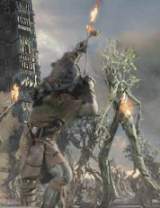 |
Fimbrethil and the other Entwives left the Ents and the wild woods to grow gardens east of the Anduin. For a time they prospered, but when Treebeard went east to seek Fimbrethil in the time of the War of the Last Alliance, he found that the gardens had become the ruined Brown Lands and that Fimbrethil and the Entwives were gone.
It is not known what happened to the Entwives. They may have perished, or they may have wandered farther east. When Treebeard began the march against Isengard on March 2, 3019 of the Third Age, he said that he would have liked to see Fimbrethil one last time.
Names &
Etymology:
Fimbrethil means either "slender
beech" or "slender birch" in Sindarin. The word fim means "slender,
slim." The word brethil is defined in different sources as either
"beech tree" or "birch tree." She was also called Wandlimb.
Sources:
The Two
Towers: "Treebeard," p. 79, 90
Appendix
F of The Lord of the Rings: "The Languages and Peoples of the Third
Age - Of Other Races," p. 409
The History
of Middle-earth, vol. V, The Lost Road and Other Writings: "The Etymologies,"
BERÉTH
entry
(defined as "beech")
The Silmarillion:
"Appendix - Elements in Quenya and Sindarin Names," entry for brethil
(defined as "birch")
Letters
of J.R.R. Tolkien: Letter #144 (re the fate of the Entwives)
The Lord
of the Rings: A Reader's Companion by Wayne G. Hammond and Christina
Scull: "Treebeard," p. 386-87
Names &
Etymology:
Leaflock was so named because
of his leafy hair, where lock refers to a lock of hair.
Leaflock was called Finglasin Elvish which also means "Leaflock" from fing meaning "lock of hair" and las meaning "leaf."
Sources:
The Two
Towers: "Treebeard," p. 78
"Nomenclature
of The Lord of the Rings," entry for Leaflock
Quickbeam |
Quickbeam
in the New Line film
|
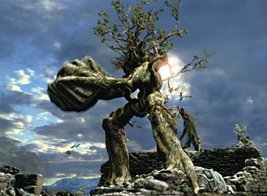 Hasty
Ent. Quickbeam was the first Ent to decide to go to war against Saruman,
and he participated in the destruction of Isengard.
Hasty
Ent. Quickbeam was the first Ent to decide to go to war against Saruman,
and he participated in the destruction of Isengard.
Quickbeam was a tall, supple Ent with smooth skin, ruddy lips, and grey-green hair. At the time of the War of the Ring, he was relatively young for an Ent, though he was still probably several thousand years old. Quickbeam laughed frequently and enjoyed singing. He was considered hasty for an Ent because he had once replied to an elder before he had finished his question. He also drank quickly.
Quickbeam originally lived on the mountain slopes west of Isengard and was one of Skinbark's people. Rowan trees were planted near his home when Quickbeam was a young Enting, and he came to love them above all other trees. But one day Quickbeam found his rowan trees lying dead, cut down by Saruman's Orcs.
Skinbark was wounded by the Orcs and retreated high up the mountain slopes. Quickbeam also left the area and moved near Derndingle in Fangorn Forest. He lived under a green bank with a spring of clear water. There was a circle of rowan trees around his home and a mossy stone inside.
On February 30, 3019 of the Third Age, Quickbeam attended the Entmoot assembled by Treebeard to determine what should be done about Saruman, whose Orcs had destroyed many trees in Fangorn. Quickbeam made up his mind to march against Saruman the first day and said that he did not need to remain at the Entmoot. Treebeard introduced Quickbeam to Merry Brandybuck and Pippin Took, and Quickbeam took the Hobbits to his home and kept them company while the Entmoot continued.
On the afternoon of March 2, the Ents decided to go to war. Quickbeam heard them and brought Merry and Pippin to join the march. When they reached Isengard, Quickbeam saw Saruman near the gate. He shouted, "The tree-killer, the tree-killer!" and ran after Saruman, almost catching the Wizard before he locked himself inside Orthanc.
The Ents tore down the walls around Isengard and destroyed the machinery and flooded the underground tunnels. Afterwards, Quickbeam stood at the foot of the stairs of Orthanc to ensure that Saruman did not escape.
After the War of the Ring, Treebeard decided to let Saruman go, and Quickbeam was entrusted with the Key of Orthanc. On August 22, 3019, Quickbeam turned the keys over to Aragorn when the King visited Isengard with Merry and Pippin and the rest of the Fellowship.
Names &
Etymology:
Quickbeam was so named because
he was considered hasty. The word beam means "tree" in Old English.
Also, "quickbeam" is an English name for the rowan tree, beloved by Quickbeam.
Also called Bregalad in Sindarin, which translates as "Quickbeam" from bragol meaning "sudden" and galad meaning "tree."
Sources:
The Two
Towers: "Treebeard," p. 86-90; "The Road to Isengard," p. 164; "Flotsam
and Jetsam," p. 170, 173
The Return
of the King: "Many Partings," p. 257, 259
The Silmarillion:
"Appendix - Elements in Quenya and Sindarin Names," entry for bragol
The History
of Middle-earth, vol. V, The Lost Road and Other Writings: "The Etymologies,"
entry for GALAD
"Nomenclature
of The Lord of the Rings," entry for Quickbeam
Quickbeam was one of Skinbark's folk. Quickbeam attended the Entmoot that began on February 30, 3019 of the Third Age, and he was the first Ent to make up his mind to march on Saruman's stronghold at Isengard.
Names &
Etymology:
Also called Fladrif in Elvish.
The name Fladrif is said to translate as "Skinbark," though the
precise etymology is uncertain.
Sources:
The Two
Towers: "Treebeard," p. 78, 87
"Nomenclature
of The Lord of the Rings," entry for Leaflock
Khamûl |
Khamul
in the New Line film
|
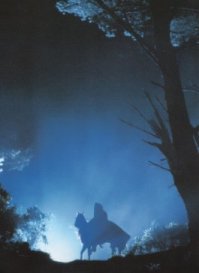 Second-in-command
of the Nazgul. Khamul is the only one of the
Nazgul whose original name is known. He was once an Easterling
- a Man from
Rhun in the far east of Middle-earth.
Khamul was given one of the Nine Rings
by Sauron and he was enslaved to Sauron's will
and became one of the Wraiths known as the Nazgul. The Nine first appeared
as Nazgul around the year 2251 of the Second Age.
Second-in-command
of the Nazgul. Khamul is the only one of the
Nazgul whose original name is known. He was once an Easterling
- a Man from
Rhun in the far east of Middle-earth.
Khamul was given one of the Nine Rings
by Sauron and he was enslaved to Sauron's will
and became one of the Wraiths known as the Nazgul. The Nine first appeared
as Nazgul around the year 2251 of the Second Age.
Khamul was one of the most powerful Nazgul, second only to the Lord of the Nazgul. He was readily able to sense the presence of the One Ring, although in daylight he became confused and his power was diminished.
In the year 2951 of the Third Age, Sauron sent Khamul as his lieutenant to command the stronghold of Dol Guldur in Mirkwood. One or two of the other Nazgul were sent with Khamul.
In March of 3018, Aragorn brought Gollum to Mirkwood to be held captive by the Elvenking Thranduil. Khamul's spies later learned of this and Khamul sent word to Sauron around late April. On June 20, Orcs from Dol Guldur attacked the Elves. Khamul may have directed the attack. Gollum escaped from captivity, but he managed to elude the Orcs as well.
That same day, the Lord of the Nazgul began the hunt for the One Ring and the land of the Hobbits known as the Shire. On July 22, Khamul met the Lord of the Nazgul in the Field of Celebrant. Khamul reported Gollum's escape and said that there were no Hobbits living in the Vales of the Anduin. The Nazgul continued searching and eventually made their way to Isengard and were directed north to Eriador.
On September 23, Khamul and three or four other Nazgul entered the Shire after defeating the Rangers at Sarn Ford.* Khamul went to Hobbiton seeking someone named Baggins. He spoke to Gaffer Gamgee, who pointed him in the direction of Buckland.
Khamul pursued Frodo Baggins and his companions down the Stock Road. He came close to catching Frodo during the day of September 24 but the Hobbits hid from him and Khamul was hesistant and uncertain in the daylight. At twilight, Khamul became more aware of the Ring and he approached Frodo in the Woody End but fled as a company of Elves led by Gildor Inglorion arrived. The presence of the Elves interfered with Khamul's ability to sense the Ring.
Khamul continued his pursuit the next day - September 25 - and the Hobbits saw him on a ridge above them and later heard his cry as he summoned another Nazgul. Khamul then went to Bamfurlong, the home of Farmer Maggot, and offered the farmer gold in exchange for news of Baggins, but Maggot refused. That evening Khamul saw the Hobbits crossing the Brandywine River using the Bucklebury Ferry, but he was unable to pursue them across the deep moving water and the river interfered with his ability to sense the Ring.
Khamul summoned the other Nazgul who had dispersed across the Shire. The five Nazgul assembled on the morning of September 26. One Nazgul was ordered to watch the Brandywine Bridge, while two others were sent along the Great East Road to report to the Witch-king.
Khamul and another Nazgul secretly entered Buckland through the North-gate. Khamul did not want to attract attention so they searched for Frodo slowly and stealthily.
On September 28, Khamul found the house at Crickhollow where Frodo had stayed. Khamul kept watch on the house and sent his companion to bring back the Nazgul who had been left guarding the Brandywine Bridge. The three assembled at Crickhollow on the night of September 29.
Khamul led an attack on the house at Crickhollow in the early hours of September 30. Frodo was long gone, but his friend Fatty Bolger had remained behind. Fatty fled and raised the alarm. The three Nazgul rode to the North-gate past the guards and out of Buckland. They rendezvoused with the Witch-king on September 30.
On the night of October 3-4, the Nazgul attacked Gandalf on Weathertop. Gandalf escaped with four Nazgul in pursuit, but Khamul and the Witch-king remained behind with three others to keep watch for the Ring-bearer.
Frodo arrived at Weathertop on October 6, and the five Nazgul tried to capture him. The Witch-king stabbed Frodo with a Morgul-knife, but Frodo invoked the name of Elbereth - one of the Valar whom the Nazgul feared - and Aragorn advanced on them with flaming brands. The Nazgul retreated, expecting Frodo to become a Wraith as a result of his wound and fall under their power.
On October 11, Khamul and two other Nazgul encountered Glorfindel on the Last Bridge. Glorfindel was one of the High Elves who had lived in the Undying Lands and had power in the Unseen world. Khamul and the other Nazgul fled from him.
The Nine Nazgul pursued Frodo to the Ford of Bruinen on October 20. Khamul followed the Witch-king into the river despite his dislike of water, but the Nazgul were washed away in a flood created by Elrond. They returned to Mordor and assumed new forms and were mounted on flying steeds called Fell Beasts.
Nothing further is known about Khamul's individual actions during the War of the Ring. The Nazgul took part in the siege of Minas Tirith and the Battle of the Pelennor Fields, where the Lord of the Nazgul perished on March 15, 3019. Khamul most likely became the leader of the Nazgul at that time.
At the Battle
of the Morannon on March 25, the Nazgul flew above the battlefield.
When Frodo claimed the Ring at Mount
Doom, Sauron summoned the Nazgul to seize him. They raced to the mountain,
but Gollum fell into the Cracks of
Doom with the Ring. Mount Doom erupted and the Nazgul were engulfed
in flames and were destroyed.
*Note:
According to "The Tale of Years" in Appendix
B of The Lord of the Rings,
four Nazgul entered the Shire while the other five pursued the Rangers
eastward. Gandalf also stated that four Nazgul entered the Shire at the
Council of Elrond (FotR, p. 277). However,
in The Lord of the Rings: A Reader's Companion
there is a much more detailed account of the Nazgul's movements prepared
by Tolkien which says five Nazgul including Khamul entered the Shire while
the other four including the Witch-king went eastward.
Names &
Etymology:
Also called the Shadow of the
East, the Black Easterling, and the Second Chief. He
is commonly referred to as Khamul the Easterling.
Sources:
The Fellowship
of the Ring: "Three is Company," p. 78-79, 84-85, 87-88; "A Short Cut
to Mushrooms," p. 98-100, 102; "A Consipiracy Unmasked," p. 109
Unfinished
Tales: "The Hunt for the Ring," p. 338-39, 344, 348, 352-53 note 1
The Lord
of the Rings: A Reader's Companion by Wayne G. Hammond and Christina
Scull: "Three Is Company," p. 97-99; "A Conspiracy Unmasked," p. 116; "A
Knife in the Dark," p. 164-68; "Flight to the Ford," p. 194-96; "The
Council of Elrond," p. 242
Alatar and Pallando wore robes of sea-blue and were known as the Blue Wizards, or Ithryn Luin. They arrived in Middle-earth around the year 1000 of the Third Age and travelled to the land of Rhun far east of the Anduin. They were accompanied by Saruman, but while Saruman eventually returned to western Middle-earth, the Blue Wizards remained in the East.
It is not certain what became of the Blue Wizards. Their task was to help free the Men of the eastern lands, where the influence of Sauron was especially strong. It is possible that the Blue Wizards may have had a certain amount of success at first, for it is noted in one source (HoME XII) that Sauron's eastern forces were not as strong as they might have been. (However, it should be noted that this source contradicts others by stating that the Blue Wizards arrived in Middle-earth during the Second Age long before the other three Wizards.)
Whether the Blue Wizards were initially successful or not, it appears that ultimately they failed in their mission. They may have perished, or they may have been corrupted by Sauron, or they may have strayed from their purpose. Tolkien speculated in Letter #211 that the Blue Wizards were the founders of "secret cults and 'magic' traditions" that continued after Sauron's downfall into the Fourth Age and possibly beyond.
Whatever their ultimate fate, the Blue Wizards did not return to the Undying Lands from whence they came. The only one of the Five Wizards to do so was Gandalf.
Names &
Etymology:
The names of the Blue Wizards are
given as Morinehtar and Rómestámo in a note
written by Tolkien late in life (HoME XII).
It is not clear whether these names were intended to replace the names
Alatar and Pallando, or whether Morinehtar and Romestamo were alternate
names for the Blue Wizards, possibly those given to them by the people
of Middle-earth.
The meanings of the names Alatar and Pallando are not known. Pallando may contain the element palan meaing "far." The name Morinehtar is translated as "Darkness-slayer" and Rómestámo is translated as "East-helper."
Ithryn Luin is Sindarin meaning "Blue Wizards." The word ithryn is the Sindarin equivalent of the Quenya word istari meaning "wise ones" or "wizards." The singular of ithryn is ithron. The word luin means "blue."
Sources:
The Two
Towers: "The Voice of Saruman," p. 188
Appendix
B of The Lord of the Rings: "The Tale of Years," p. 365
Unfinished
Tales: "The Istari," p. 388-95, 401 note 6
The History
of Middle-earth, vol. XII, The Peoples of Middle-earth: "Last Writings
- The Five Wizards," p. 384-85
The Letters
of J.R.R. Tolkien: Letter #211
Radagast the Brown |
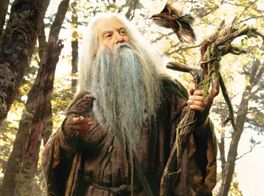 Wizard
associated with animals and nature. Radagast was one of the Five Wizards
sent to Middle-earth in the Third Age. The Wizards were Maiar spirits who
took the form of old men. They were selected by the Valar to encourage
the peoples of Middle-earth to oppose Sauron.
Radagast was a Maia named Aiwendel. He was selected by Yavanna, the Vala
of growing things. According to one tale, Yavanna asked Curumo - who became
known as Saruman - to take Aiwendel with him
to Middle-earth.
Wizard
associated with animals and nature. Radagast was one of the Five Wizards
sent to Middle-earth in the Third Age. The Wizards were Maiar spirits who
took the form of old men. They were selected by the Valar to encourage
the peoples of Middle-earth to oppose Sauron.
Radagast was a Maia named Aiwendel. He was selected by Yavanna, the Vala
of growing things. According to one tale, Yavanna asked Curumo - who became
known as Saruman - to take Aiwendel with him
to Middle-earth.
In Middle-earth, Radagast made his home at Rhosgobel on the western border of Mirkwood. He was known to Beorn, the skin-changer who lived to the north near the Carrock. Radagast was a master of shapes and changes of hue and he was knowledgeable in the lore of animals and plants. He befriended beasts and especially birds and he was able to communicate with them. Radagast spent most of his time with wildlife and had little time for Elves and Men.
In the summer of 3018, Radagast was contacted by Saruman, the head of the Order of Wizards. Saruman told Radagast to seek Gandalf the Grey and tell him that the Nazgul were abroad seeking news of the Shire and that if Gandalf wanted aid he should come to Isengard at once. Radagast was an honest Wizard and he did not realize that Saruman was deceiving him and using him to lay a trap for Gandalf.
Radagast found Gandalf at Midsummer on the Greenway near Bree and delivered Saruman's message. Gandalf asked Radagast to tell the birds and beasts to bring any news of the Enemy's plans to Isengard. Radagast rode to Mirkwood and spread the word among his friends. The Great Eagles flew far and wide and gathered news of the Nazgul and the mustering of Orcs and Wargs and the escape of Gollum from Mirkwood. Then Gwaihir the Windlord went to Isengard where he found Gandalf imprisoned on the pinnacle of Orthanc and helped him escape.
This is all that is known of Radagast's activities during the War of the Ring. While his affinity with nature was useful to Gandalf, overall it appears that Radagast neglected his mission to assist the peoples of Middle-earth in their struggle against Sauron. It is said that of the Five Wizards only Gandalf remained faithful to his task and that he was the only one allowed to return to the Undying Lands. It may be that Radagast remained in Middle-earth among the wild things that he loved for a time, but his ultimate fate is unknown.
Names &
Etymology:
In the essay "The
Istari" the name Radagast is said to mean "tender of beasts"
in the language of Numenor. However, in a later
note Tolkien says that the name is in the language of the Men of the Vales
of the Anduin and that its meaning is
not interpretable.
The name Radagast may also be related to Old English. The word gast means "ghost, spirit, angel." The element rad could be derived from the word gerád meaning "wise" or possibly from rudu meaning "ruddy, reddish."
There was also said to be a Slavic god named Radagast who was the god of travellers and the patron of hospitality. His name was from the Old Slavonic raditi meaning "take care, look after, consider" and gost meaning "guest, stranger, foreigner."
As a Maia, Radagast was called Aiwendel meaning "friend of birds" in Quenya from aiwe meaning "birds" and -nil or -ndil meaning "friend."
Saruman scornfully referred to Radagast as Radagast the Bird-tamer, Radagast the Simple, and Radagast the Fool.
Sources:
The Hobbit:
"Queer Lodgings," p. 129
The Fellowship
of the Ring: "The Council of Elrond," p. 269-71, 272, 274
Unfinished
Tales: "The Istari," p. 389-90, 392-95, 401 note 4
The History
of Middle-earth, vol. V, The Lost Road and Other Writings: "The Etymologies,"
entries for AIWE and NIL, NDIL
Letters
of J.R.R. Tolkien: Letter #156 (on Gandalf as the only faithful Wizard)
The
Encyclopedia of Arda (etymology of Radagast)
Old English
Tom Bombadil |
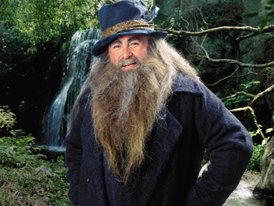 An
enigmatic individual who had a close kinship with nature. It is not known
exactly who or what Tom Bombadil was. Some say he was a spirit of nature
or an embodiment of Nature itself; others say he was a Maia or even a Vala.
Tom himself said, "Don't you know my name yet? That's the only answer.
Tell me, who are you, alone, yourself and nameless?"
(FotR,
142) Goldberry called Tom "the Master of wood, water, and hill."
(FotR,
135) J.R.R. Tolkien said Tom was intentionally an enigma. (Letters,
#144) But whatever Tom's precise identity, he was clearly a unique
presence in Middle-earth, and one over whom the
Ring had no power.
An
enigmatic individual who had a close kinship with nature. It is not known
exactly who or what Tom Bombadil was. Some say he was a spirit of nature
or an embodiment of Nature itself; others say he was a Maia or even a Vala.
Tom himself said, "Don't you know my name yet? That's the only answer.
Tell me, who are you, alone, yourself and nameless?"
(FotR,
142) Goldberry called Tom "the Master of wood, water, and hill."
(FotR,
135) J.R.R. Tolkien said Tom was intentionally an enigma. (Letters,
#144) But whatever Tom's precise identity, he was clearly a unique
presence in Middle-earth, and one over whom the
Ring had no power.
Tom was an ancient being. He seems to have been in Middle-earth from the beginning.
"Eldest, that's what I am... Tom was here before the river and the trees; Tom remembers the first raindrop and the first acorn. He made paths before the Big People, and saw the little People arriving. He was here before the Kings and the graves and the Barrow-wights. When the Elves passed westward, Tom was here already, before the seas were bent. He knew the dark under the stars when it was fearless - before the Dark Lord came from Outside."In appearance, Tom was like a Man though somewhat shorter. He wore a blue coat and big yellow boots and a battered hat with a blue feather. He had a long brown beard, bright blue eyes, and a red face creased with laughter. Tom was a merry old fellow and he enjoyed laughing and singing.
The Fellowship of the Ring: "In the House of Tom Bombadil," p. 142
Tom lived in a house on the side of a hill between the Old Forest and the Barrow-downs. Tom called this area - bordered on the north by the Great East Road - his country, though the land and the living things there belonged to themselves, not to Tom. Tom did not often cross the borders of his country, though he had been to visit Farmer Maggot in the Shire and he was acquainted with Barliman Butterbur at the Prancing Pony in Bree.
Goldberry, the River-woman's daughter, was Tom's wife. He had found her one day in a pool far down the River Withywindle. Each year at the end of summer, Tom would go along the river to gather water lilies for Goldberry. It was on his last trip of the year in September of 3018 of the Third Age that he met Frodo Baggins. Frodo's companions Merry Brandybuck and Pippin Took had been trapped by Old Man Willow. Tom sang to Old Man Willow and told him to release the Hobbits, and he then invited them to follow him to his home.
The Hobbits spent two nights in the house of Tom Bombadil. He told them many stories about the forest and the land and the kingdoms that had come and gone. Frodo found himself telling Tom about his troubles, and Tom asked to see the Ring. Tom put the Ring on his finger but he did not become invisible, and when Frodo put the Ring on Tom was able to see him. Tom did not appear to be influenced by the lure of the Ring but instead easily returned it to Frodo with a smile.
When the Hobbits left Tom's house on the morning of September 28, Tom advised them to make their way north to the Great East Road through the Barrow-downs and to pass the barrows on the west side. But the Hobbits became disoriented in the fog and were captured by a Barrow-wight. Frodo sang the song Tom had taught him and Tom appeared and sang a song to banish the Barrow-wight.
Tom then spread the gold and treasures from the barrow on the grass so that the barrow's spell was broken and no Wight would return to it. For Goldberry, Tom took a brooch set with blue stones which he sadly recalled had belonged to a fair lady who died long ago. He then escorted the Hobbits to the Road, riding on his pony Fatty Lumpkin, but he would go no further.
Later that night, Merry's ponies were set loose from the stables of the Prancing Pony in Bree. The ponies went to the downs in search of Fatty Lumpkin. Tom took care of them and then sent them to Barliman Butterbur.
At the Council of Elrond, the possibility of giving the Ring to Tom for safekeeping was discussed and rejected. Gandalf said that although the Ring had no power over Tom, Tom had no power over the Ring: he could not alter the Ring or break its power over others. Tom might take the Ring if asked, but he would not understand the need to guard it safely, nor would he be able to withstand an assault on his land by Sauron. Glorfindelremarked, "I think that in the end, if all else is conquered, Bombadil will fall, Last as he was First; and then Night will come." (FotR, p. 279)
After the War of the Ring, Gandalf went to visit Tom Bombadil and they had a long talk.
Names &
Etymology:
Tom was called Iarwain Ben-adar
by the Elves, meaning "oldest and fatherless." The Northern Men called
him Orald which is from the Old English oreald meaning "of
great age." The Dwarves called Tom Forn, which is a Scandinavian
word meaning "(belonging to) ancient (days)."
Tom Bombadil was originally the name of a Dutch doll belonging to Michael Tolkien, J.R.R. Tolkien's son.
Sources:
The Fellowship
of the Ring: "The Old Forest," p. 130-33; "In the House of Tom Bombadil,"
passim; "Fog on the Barrow-downs," 153-59; "The Council of Elrond," p.
278-79
The Return
of the King: "Homeward Bound," p. 275
The Adventures
of Tom Bombadil: Preface; "The Adventures of Tom Bombadil"; "Bombadil
Goes Boating"
Letters
of J.R.R. Tolkien, #144 & #153
"Nomenclature
of The Lord of the Rings," entry for Orald
Goldberry |
 Wife
of Tom Bombadil. Goldberry was slender and
beautiful with long golden hair. She was as fair as an Elf-maiden, but
she was earthier and less remote.
Wife
of Tom Bombadil. Goldberry was slender and
beautiful with long golden hair. She was as fair as an Elf-maiden, but
she was earthier and less remote.
Goldberry was the daughter of the River-woman of the Withywindle. Nothing is known about the River-woman; she may have been a naiad or water-spirit or some kind of embodiment of the River itself. It is not known exactly what kind of being Goldberry was either, but like Tom Bombadil, she seems to have had a close kinship with nature. Goldberry had some power over water, for her song could bring the rain. She was also attuned to the changing of the seasons in the river-lands where she lived.
Goldberry originally dwelled with her mother in a deep hollow of the River Withywindle. One day Tom Bombadil came along and dangled his beard in the river, and Goldberry grabbed it and pulled him into the water. Tom later returned and took Goldberry home with him and married her. They lived in a house on the eastern edge of the Old Forest near the Barrow-downs. Each spring, Goldberry returned to the river to bathe in the waters.
At the end of each summer, Tom gathered water-lillies for Goldberry, which she kept in bowls of water during the winter months. On September 26, 3018 of the Third Age, Tom returned home with lilies and four Hobbits. Frodo Baggins was smitten with Goldberry, and she recognized a special quality in him and called him "elf-friend."
The Hobbits spent two nights in the house of Tom Bombadil, and on the morning of September 28, Goldberry met them at the edge of the Barrow-downs and wished them a safe and speedy journey. But the Hobbits were captured by a Barrow-wight, and after Tom rescued them he took from the barrow a brooch set with blue stones to bring home to Goldberry.
Names &
Etymology:
Goldberry was also called
River-daughter.
Sources:
The Fellowship
of the Ring: "The Old Forest," p. 130-33; "In the House of Tom Bombadil,"
passim; "Fog on the Barrow-downs," p. 146-47; 156-57
"The Adventures
of Tom Bombadil" in A Tolkien Reader
The Letters
of J.R.R. Tolkien: Letter #210
GothmogLieutenant of Minas Morgul. Gothmog was the second-in-command of the Enemy forces at the Battle of the Pelennor Fields on March 15, 3019 of the Third Age. After the demise of his commander - the Lord of the Nazgul - Gothmog assumed command. Gothmog sent more troops onto the field from Osgiliath including Easterlings, Southrons, Variags, and Men of Far Harad. The battle began to turn in favor of the Enemy, but then Aragorn arrived in the Corsairs' ships with reinforcements and Gothmog's forces were defeated.Movie Note:
Names &
Etymology:
Sources:
|
King of the Dead & The Dead |
The
King of the Dead
in the New Line film |
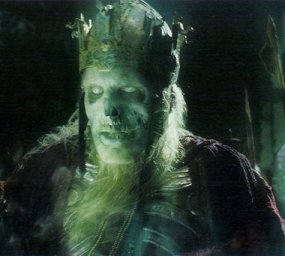 Ghosts
of Men who haunted the Paths of
the Dead. The King of the Dead and his followers were once living Men.
They dwelled in the White Mountains
and were known as the Men of the Mountains. They were related to the Men
of Dunland.
Ghosts
of Men who haunted the Paths of
the Dead. The King of the Dead and his followers were once living Men.
They dwelled in the White Mountains
and were known as the Men of the Mountains. They were related to the Men
of Dunland.
The Men of the Mountains worshipped Sauron, but after the realm of Gondor was founded in 3320 of the Second Age, the King of the Mountains swore allegiance to Isildur. At the Stone of Erech, the King vowed that he would lead his Men in battle against the forces of Sauron.
But when they were summoned during the War of the Last Alliance, the King and his Men broke their oath and refused to fight their former master. Isildur told the King of the Mountains that he would be the last king and he cursed the Oathbreakers, saying that they would never rest until their oath was fulfilled.
The King and his Men hid in the White Mountains. Over time they died but their spirits continued to haunt the mountains and the King of the Mountains became known as the King of the Dead. The Dead dwelled in the passage under the mountains known as the Paths of the Dead. They sometimes emerged into Harrowdale and the Blackroot Vale.
The Dead did not allow the living to enter their domain. In 2570 of the Third Age, Baldor, son of King Brego of Rohan, entered the Paths of the Dead. The Dead followed Baldor silently through the Paths of the Dead to the door of an evil temple hall, where they broke his legs and left him to die.
On March 8, 3019, Aragorn and the Grey Company entered the Paths of the Dead. Aragorn summoned the Dead to follow him to the Stone of Erech and they did so. At midnight at the Stone of Erech, Aragorn asked the Dead why they had come and they replied, "To fulfil our oath and have peace." (RotK, p. 63) Aragorn then revealed himself to be Isildur's heir and he called on the Dead to fight the forces of Sauron.
The Dead followed Aragorn to the port of Pelargir on the Anduin, a journey of approximately 280 miles. There they found the fleet of the Corsairs of Umbar who were allies of Sauron. At Aragorn's command, the Dead boarded the ships and the Corsairs fled in fear before them. Aragorn later used the fleet to come to the aid of Minas Tirith at the Battle of the Pelennor Fields.
After the fleet was captured, the Dead came before Aragorn and he declared that their oath was fulfilled and that they could finally rest.
"And thereupon the King of the Dead stood out before the host and broke his spear and cast it down. Then he bowed low and turned away; and swiftly the whole grey host drew off and vanished like a mist that is driven back by a sudden wind ..."
The Return of the King: "The Last Debate," p. 153
Movie
Note:
In Peter Jackson's film version
of The Lord of the Rings,
the Dead follow Aragorn all the way to Minas Tirith and fight in the Battle
of the Pelennor Fields.
Names &
Etymology:
The King of the Dead was
originally called the King of the Mountains and his followers were
the Men of the Mountains. They became known as the Oathbreakers
because they refused to fight Sauron as they had promised. They were also
called the Dead Men of Dunharrow because the entrance to the Paths
of the Dead was in Dunharrow. Also
known as the Dead, the Sleepless Dead, the Grey Host, the Shadow Host,
and
the
Shadow-men.
Sources:
The Return
of the King: "The Passing of the Grey Company," p. 55, 59-63; "The
Muster of Rohan," p. 70-71; "The Last Debate," p. 150-53
Appendix
F of The Lord of the Rings: "The Languages and Peoples of the Third
Age," p. 407-8
"The Rivers
and Beacon-hills of Gondor," by J.R.R. Tolkien, edited by Carl F. Hostetter,
commentary by Christopher Tolkien, in Vinyar Tengwar #42, July 2001,
p. 22 note 6 (on the locked door and Baldor's fate)
All entries are Copyright © by the Thain from former tuckborough.net. Please contact me if you are Thain or know anything about how to contact the original author.
2003-2011, The Thain's Book - thainsbook.minastirith.cz
- e-mail: thain at tuckborough.net